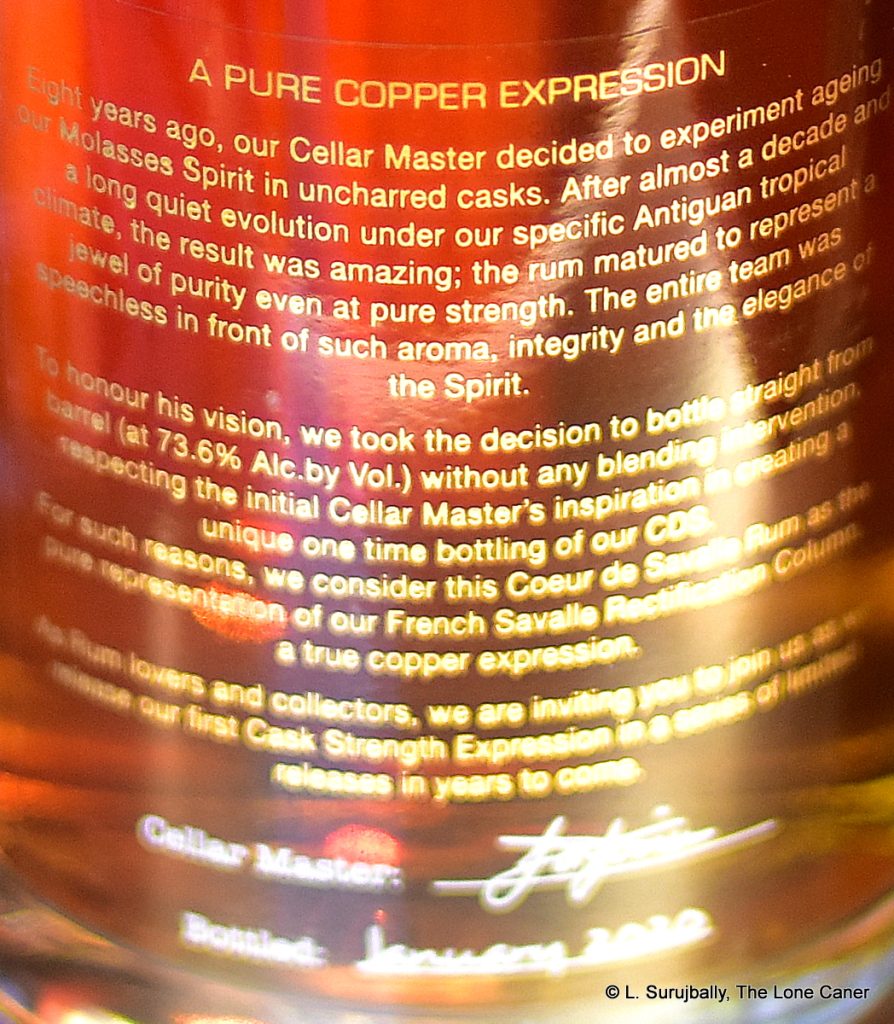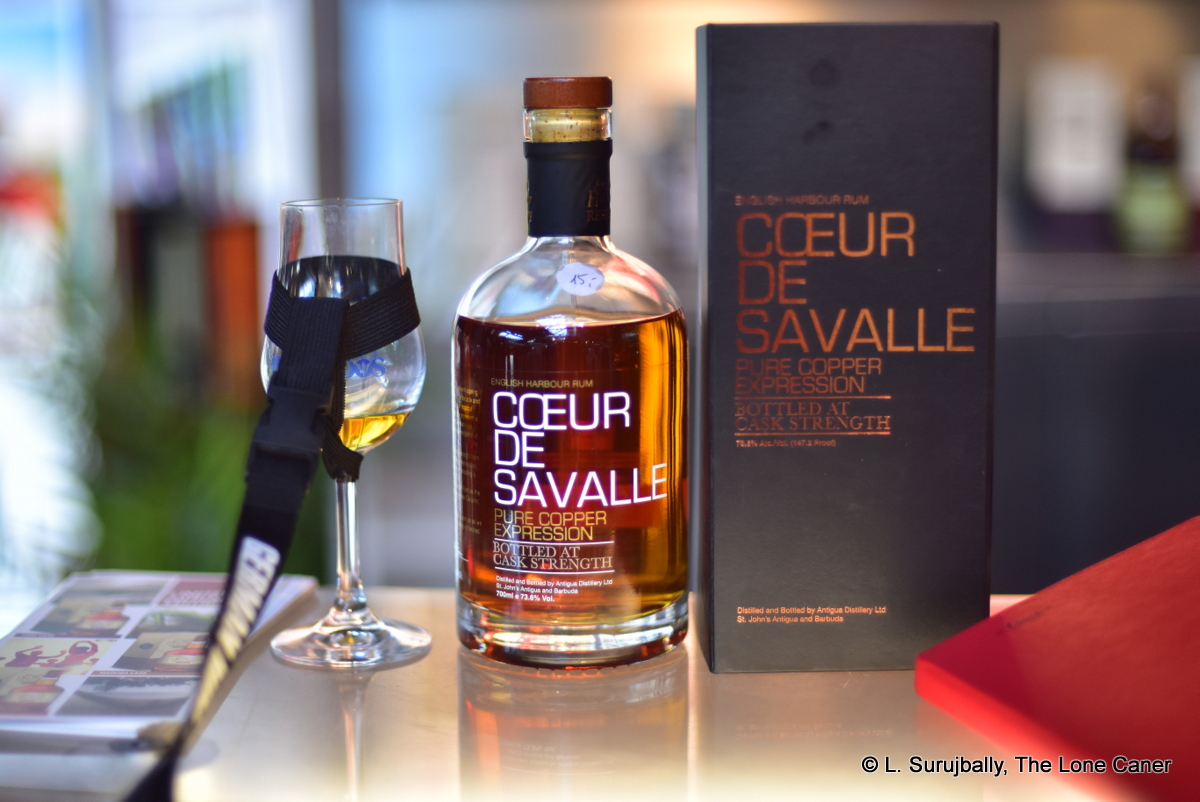Antigua Distillers, the makers of the English Harbour brand of rums, has always held a soft spot in my heart, since it was their exceptional 1981 25 YO which kickstarted my desire to not just jot down tasting notes at the Liquorature rum club, but to actually go publish them (it’s review #R-0001). Over the years that followed I tried as many of their offerings as could be reasonably acquired: their standard five year old and 10 year old rums, the port, madeira and sherry cask experimentals, and some of the High Congener series. Sometime around 2021 they whipped out this massive codpiece of a rum, strong enough to give Victorian ladies and their swains the vapours. It was issued at rompin’ stompin’ kick-ass-and-chew-bubble-gum strength of 73.6% ABV, like nothing else they had ever done before, and as soon as I heard about it, well, it excited my curiosity way beyond reasonable avarice.
The Cœur de Savalle came from the older 4-column savalle still they had installed in 1966 (later replaced – or at least eclipsed – by the John Dore which went up in 1991); it’s kind of a limited edition but the exact outturn is unclear – what is obvious from even a brief tasting is that it’s one of the most uncompromising beefcake rums English Harbour has ever made. It had its genesis in the mad dreams of the previous master blender and cellar master of the company, who wanted to produce a special off the rails cask-strength rum that showcased the savalle still to the max (hence the title “Heart of the Savalle”). To do so they chucked a higher than usual proof new-make spirit (80%) into eight uncharred and of course forgot all about it until the new cellar master/master blender found them almost a decade later. At that point the distillate was so good that it was promptly bottled as it was, before they even knew the strength (the labels were printed later).
 Smelling it, you can see why they were so excited. Column still or not, the nose on the rum is immense: huge initial fruity vanilla notes meld with tawny salted caramel, chocolate oranges and even some light mint, all biffing your hooter without apology. There’s toffee, blackberries and occasional flashes of leather and coconut shavings, and compared to others of equal strength and greater age, perhaps not a whole lot – but what is there is at least emphatic and clear without any muddling or undue savagery, and remains quite aromatic.
Smelling it, you can see why they were so excited. Column still or not, the nose on the rum is immense: huge initial fruity vanilla notes meld with tawny salted caramel, chocolate oranges and even some light mint, all biffing your hooter without apology. There’s toffee, blackberries and occasional flashes of leather and coconut shavings, and compared to others of equal strength and greater age, perhaps not a whole lot – but what is there is at least emphatic and clear without any muddling or undue savagery, and remains quite aromatic.
Palate remains quite fierce and spicy on the initial sips; then it quietens down (either some time or some water will help here). Bitter chocolate and hot sweet black tea mix it up with toblerone, crushed almonds and walnuts, plus a tinge of red wine, some cinnamon. There’s also a hint of brine and a pleasant last taste of bananas and light cherries in syrup, which last is thankfully very much in the background and doesn’t ever become cloying. The finish is long and tangy with both unripe and overripe fruits, some flowers and white chocolate, quite hot but by no means unbearable nor unpleasant.
All in all, it’s a really good rum, and oddly, the strength is not an issue. Sure it’s spicy, but so are many other rums north of 60%. Here it’s all about the taste and those are vibrant, quivering and alive and give a good account of themselves. Some smoothening out could have been accomplished with a bit more ageing, but for what it is – a rum in the middle aged sweet spot of taste and texture – there’s nothing at wrong with it, and much that is right. It walks a fine line between a brawny cane cutter’s after-hours libation and a more elegant sipping experience in the planter’s house, without ever making a case for one over the other. That’s quite a neat trick and it makes the rum one to savour and enjoy, no matter where you have it, or how. I quite liked it.
(#1014)(86/100) ⭐⭐⭐½
Other notes
- The Rumcast episode #83 took a deep dive into English Harbour’s history and various releases over time, including the backstory of this rum at around the 57 minute mark.
- The naming of English Harbour was necessary because in the 1980s some enterprising American trademarked the name in the US, just as Antigua Distillers was seeking to export its increasingly popular (Cavalier) rums there. The new name came from the location of a famous annual regatta held on the island, but interestingly, Antiguans themselves initially disliked the title, preferring the old one – this led to Cavalier remaining the rum of choice on the island, while English Harbour is the brand name for the exports.
- Eight barrels were filled so assuming an average outturn of 300 bottles per barrel after the eight years, I would hazard a guess that the final outturn was around 2400 bottles, give or take.
Brief company background
It’s been a while so a reminder of the salient details is useful for those not familiar with the company. English Harbour rums are made by Antigua Distillers: this company was founded in 1933 as a collective enterprise funded by several Portuguese rum shop owners (descendants of indentured servants from Madeira), who pooled their resources to put up a distillery whose output they then shared in proportion to their investment — each then produced a blended rum of their own from that allocation. Acquisition of nine sugar estates followed, rum production flourished in the post-war years, and inevitably Antigua Distillers came up with its own house brands, starting with the Caballero (or Cavalier) Muscovado rum. Over time it morphed and became known as Cavalier rums by the 1950s (as muscovado molasses became harder to come by) and this was itself subsumed into the English Harbour rebranding in 1993, and after which the first famed “1981” was released (the Cavalier brand has not yet been retired completely).
